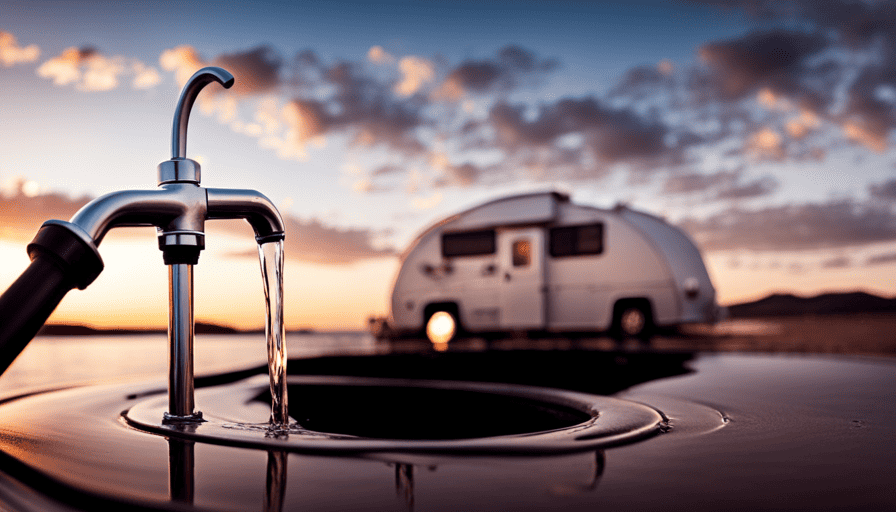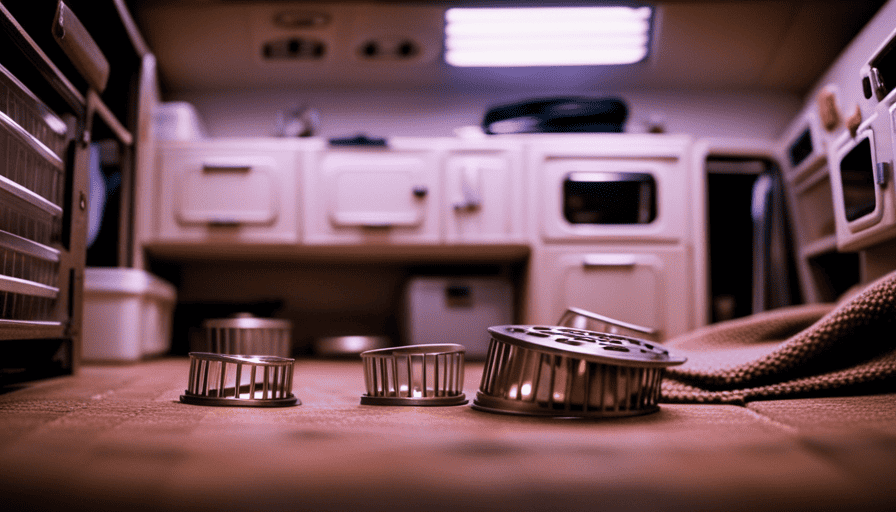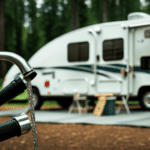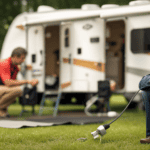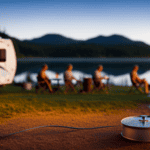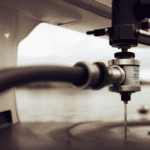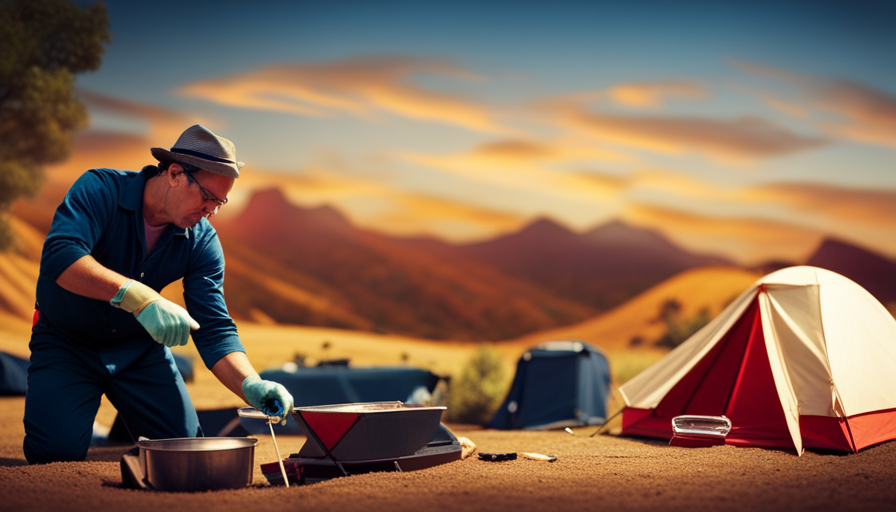Don’t stress if you’re finding it daunting to connect water to a camper. I am here to guide you through every step of the way.
Picture this: you’re in the middle of a breathtaking campground, surrounded by majestic trees and pristine nature. The only thing missing is a refreshing shower or a clean glass of water. That’s where hooking up water to your camper comes in. With the right equipment and a little know-how, you’ll be able to enjoy all the comforts of home while on your camping adventures.
In this article, I’ll walk you through the process of connecting your camper to a water source. We’ll start by gathering the necessary equipment and locating the water source.
Then, we’ll connect the water hose to the source and attach it to your camper’s water inlet. After that, we’ll turn on the water supply and prime the water pump if needed. We’ll test the water system to ensure everything is working properly, and then we’ll disconnect the water supply when you’re ready to hit the road.
Finally, I’ll give you some tips on properly storing and maintaining your equipment. So, let’s dive in and get your camper hooked up to water!
Key Takeaways
- Gather necessary equipment
- Connect the water hose securely and leak-free
- Prime the water pump
- Test the water system
Gather the Necessary Equipment
Now that you’ve got your camper ready for adventure, it’s time to gather all the necessary equipment to hook up water and make your camping experience even more convenient and enjoyable!
The first step is choosing the right water hose. It’s important to select a hose that is specifically designed for RV use. Look for a hose that is drinking water safe and labeled as suitable for potable water. These hoses are typically made from materials that won’t impart any unwanted taste or odor to your water supply. Additionally, make sure the hose is long enough to reach from the water source to your camper without any kinks or tangles.
Once you have your hose, the next step is ensuring proper water pressure. Most RVs require a water pressure of around 40-60 psi. To achieve this, consider using a water pressure regulator. This handy device will help protect your camper’s plumbing system from any potential damage caused by high water pressure. Simply attach the regulator to the hose before connecting it to the water source.
With the right hose and proper water pressure, you’re now ready to locate the water source. This can typically be found at designated water hook-up points in campgrounds or RV parks. Look for a water spigot or hydrant and connect your hose securely.
Locate the Water Source
First, you’ll need to find the nearby river or stream where your camper can quench its thirst, just like a traveler seeking an oasis in the desert. Finding nearby campsites is crucial for this step, as they often provide access to water sources.
Look for campsites that are situated near rivers, streams, or lakes. These natural water sources are ideal for hooking up water to your camper.
Once you’ve located a suitable campsite, the next step is to choose the right water hose. It’s important to select a hose that’s specifically designed for RV use. These hoses are typically made of non-toxic materials that won’t impart any unpleasant taste or odor to your water supply. They also have fittings that are compatible with RV water systems.
When connecting the water hose to the source, make sure to use a hose connector that matches the water source’s fittings. This will ensure a secure and leak-free connection. Attach one end of the hose to the water source and the other end to the camper’s water inlet. Make sure the connections are tight to prevent any water leakage.
With the water hose securely connected, you’re ready to move on to the next step of the process. Now, let’s discuss how to connect the water hose to your camper’s water system.
Connect the Water Hose to the Source
Once the suitable campsite has been found near a water source, it’s time to connect the hose to ensure a secure and leak-free connection. Water pressure regulation is crucial to prevent any damage to the camper’s plumbing system. To achieve this, a water pressure regulator should be attached to the hose before connecting it to the water source. This device regulates the water pressure, ensuring a safe and consistent flow.
When selecting a water hose, it is important to consider its material and length. There are two common types of water hoses available for campers: vinyl and reinforced rubber hoses. Vinyl hoses are lightweight and less expensive, but they may kink easily and have lower durability. On the other hand, reinforced rubber hoses are more durable and resistant to kinking, but they are heavier and pricier.
To connect the water hose to the source, follow these steps:
- Attach a water pressure regulator to the hose.
- Connect one end of the hose to the water source, ensuring a tight connection.
- Open the water source slowly to avoid sudden pressure surges.
- Check for any leaks or drips around the connections.
- Once everything is secure, transition to attaching the hose to the camper’s water inlet.
By following these steps, you can ensure a reliable water supply throughout your camping trip. Now, let’s move on to the next section and discuss how to attach the hose to the camper’s water inlet.
Attach the Hose to the Camper’s Water Inlet
To successfully connect the hose to the camper’s water inlet, a secure and tight attachment is essential. First, make sure the camper’s water inlet is clean and free of debris to prevent clogs or blockages in the water system. Next, align the end of the water hose with the camper’s water inlet and push it onto the inlet, ensuring a snug fit. Some campers may have a screw-on connection, so be sure to tighten it properly. Check for leaks or drips after attaching the hose. If there are any leaks, tighten the connections or replace damaged parts.
Properly securing the hose to the camper’s water inlet is crucial for maintaining the water system. Regularly inspect the connections for signs of wear or damage. It’s also recommended to use a water pressure regulator to protect the camper’s plumbing system from high water pressure, preventing potential damage to pipes and fittings.
Now that the hose is securely attached to the camper’s water inlet, it’s time to turn on the water supply.
Turn on the Water Supply
Now, let the refreshing rush of liquid life flow through your hose by simply twisting the valve and welcoming the water wonderland into your camper.
Before you turn on the water supply, it’s important to troubleshoot any potential issues to ensure a smooth flow of water. Here are some tips to help you troubleshoot water supply issues:
-
Check the water pressure: Make sure the water pressure is within the recommended range for your camper. Low water pressure can indicate a problem with the water source or a blockage in the system.
-
Inspect the hose: Check for any kinks, leaks, or damages in the hose. These can cause water supply issues and affect the overall flow of water.
-
Test the connections: Ensure that all connections are tight and secure. Loose connections can lead to leaks and water wastage.
-
Clean the water filter: If your camper has a water filter, clean or replace it regularly to prevent clogs and maintain optimal water flow.
-
Bleed the air: Sometimes, air can get trapped in the water lines, causing a disruption in the water supply. To fix this, open all faucets and let the water run for a few minutes to bleed out the air.
In addition to troubleshooting, it’s important to conserve water while camping. Here are some tips for water conservation:
-
Take shorter showers: Limit your shower time to conserve water.
-
Collect and reuse water: Use a basin to collect water while washing dishes or brushing your teeth, and reuse it for other purposes.
-
Fix leaks promptly: Check for any leaks in your camper’s plumbing system and fix them as soon as possible to prevent water wastage.
Now that you know how to troubleshoot water supply issues and conserve water while camping, it’s time to move on to the next step: checking for leaks.
Check for Leaks
After successfully turning on the water supply, the next step is to check for any leaks. This is a crucial step to ensure that the water system is properly connected and functioning. Common causes of leaks include loose fittings, damaged pipes, or faulty connections. Troubleshooting leaks is essential to prevent water damage and to maintain the integrity of your camper.
To check for leaks, follow these steps:
- Start by visually inspecting all the connections, fittings, and pipes for any signs of water leakage.
- Use a dry cloth or tissue to wipe the fittings and connections. If there is any moisture, it indicates a leak.
- Pay close attention to areas where pipes and fittings meet, as these are common areas for leaks to occur.
- If you notice a leak, tighten the fittings or connections using a wrench or adjust them as needed.
- Repeat the process of wiping and checking for leaks until all connections are secure and dry.
Remember to be thorough in your inspection, as even a small leak can lead to significant water damage over time. Once you have ensured that there are no leaks, you can proceed to prime the water pump (if applicable).
Now, let’s move on to priming the water pump (if applicable).
Prime the Water Pump (If Applicable)
Before we get started, let’s make sure the water pump’s properly primed (if needed), so you can enjoy a seamless and refreshing camping experience. Priming the water pump’s crucial to ensure proper water flow in your camper. To prime the water pump, you first need to locate it. It’s usually found near the water tank or inside a compartment.
Once located, make sure the pump’s turned off before proceeding.
To prime the water pump, you’ll need to connect a water hose to the camper’s fresh water inlet. When choosing a water hose, opt for one that’s specifically designed for RV use. These hoses’re made from non-toxic materials and’re resistant to kinking and UV damage. Attach one end of the hose to the fresh water inlet and the other end to a water source.
Next, turn on the water source and open a faucet inside the camper. This’ll allow water to flow through the hose and into the system, helping to remove any air pockets and prime the pump. Keep the faucet open until a steady stream of water flows out without any sputtering or air bubbles.
With the water pump properly primed, you can now move on to the next step and test the water system for any leaks or issues.
Test the Water System
To ensure a hassle-free camping experience, it’s time to put the water system to the test and make sure everything is in working order. Testing the water system is an essential step to avoid any issues while on the road.
Start by turning on the water pump and checking for any leaks or unusual noises. If there are any issues, troubleshoot them by checking the pump’s connections and ensuring it’s properly primed.
Next, turn on the faucets and inspect for consistent water flow. If the water flow is weak or there are water spurts, it could indicate a clogged filter or air in the system. In this case, clean or replace the filter and bleed the system to remove any trapped air.
Additionally, check the hot water system by running the hot water faucet and ensuring it heats up properly.
Finally, test the toilet, shower, and any other water appliances to ensure they’re functioning correctly.
By taking the time to test the water system, you can identify and address any issues before hitting the road.
To disconnect the water supply, follow the subsequent section.
Disconnect the Water Supply
Once you’ve ensured a smooth water system, it’s time to disconnect the water supply and prepare for your camping adventure. To properly disconnect the water supply, follow these steps:
-
Turn off the water source: Locate the water valve or faucet that supplies water to your camper and turn it off. This prevents any water from flowing into the system while you disconnect it.
-
Inspect the connections: Take a close look at the water connections to make sure they’re secure and free from any leaks. If you notice any issues, such as loose connections or leaks, now’s the time to address them before disconnecting.
-
Disconnect the hoses: Begin by unscrewing the hose connections from the camper’s water inlet and the water source. Be careful not to twist or damage the hoses during this process.
Once you’ve successfully disconnected the water supply, you’re ready to move on to the next step of your camping adventure. In the next section, we’ll discuss how to properly store and maintain the equipment for future use.
Properly Store and Maintain the Equipment
Now that the water supply is disconnected, it’s time to ensure that your equipment is properly stored and maintained for future use, allowing you to relive those unforgettable camping memories.
Proper storage techniques and regular maintenance are essential to keep your water hookup equipment in good condition and ready for your next adventure.
When it comes to storing your water hookup equipment, it’s important to keep it in a clean and dry area. Make sure to remove any dirt or debris from the hoses and fittings before storing them. It’s also a good idea to coil the hoses neatly to prevent any kinks or tangles. Storing your equipment in a designated container or bag can help protect it from dust and damage.
Regular maintenance is crucial for the longevity of your water hookup equipment. Inspect the hoses and fittings for any signs of wear or damage, such as cracks or leaks. Replace any damaged components promptly to avoid any issues during your next camping trip. It’s also recommended to flush out the hoses periodically to remove any buildup or contaminants.
By following proper storage techniques and conducting regular maintenance, you can ensure that your water hookup equipment remains in optimal condition, ready to provide you with a reliable water supply during your camping adventures.
Frequently Asked Questions
How do I choose the right water hose for my camper?
When it comes to selecting the perfect water hose for your camper, there are a few key factors to consider.
Firstly, you’ll want to choose a hose that’s specifically designed for RV use, as it’ll have the necessary durability and flexibility.
Additionally, look for a hose with a built-in water filter, ensuring that you have clean and safe water for your camper.
Lastly, don’t forget to regularly sanitize your water system to maintain optimal hygiene and prevent any potential issues.
Can I use a regular garden hose for connecting water to my camper?
Yes, you can use a filter on your garden hose for connecting water to your camper. It’s recommended to use a filter to remove impurities and ensure clean water supply. However, it’s important to check the compatibility of the filter with your garden hose and camper’s water system.
As for alternative methods, besides using a garden hose, you can consider using a dedicated RV water hose or a water tank with a pump for a more efficient and reliable water connection.
Is it necessary to use a water pressure regulator when hooking up water to a camper?
Using a water pressure regulator when connecting water to a camper is highly recommended. It’s like having a guardian angel for your plumbing system, ensuring a smooth and safe water flow. This device controls the pressure and prevents any potential damage to your pipes and fixtures.
However, if you don’t have a regulator, you can use alternative options like adjustable water pressure valves or pressure-reducing fittings. These provide similar benefits and help maintain a steady water supply without risking any costly repairs.
What should I do if I notice a leak after connecting the water hose to the camper?
If I notice a leak after connecting the water hose to the camper, I’d immediately take the necessary steps to prevent further water leaks and troubleshoot the water system.
First, I’d turn off the water supply to stop the flow and prevent any further damage. Then, I’d carefully inspect the connection points and fittings for any signs of damage or loose connections. If necessary, I’d tighten or replace any faulty components to ensure a proper seal and prevent future leaks.
How often should I check and maintain the water system in my camper?
I should regularly check and maintain the water system in my camper to ensure it functions properly. It’s recommended to sanitize the water system at least once a year, or more frequently if the camper is frequently used or in areas with poor water quality.
Common issues with camper water systems include leaks, clogged pipes, and malfunctioning pumps. Regular inspections and proactive maintenance can help prevent these issues and ensure a reliable water supply during camping trips.
Can I Jack Up My Camper to Access the Water Hookup?
When setting up a camper, many wonder if they can jack it up to access the water hookup. The answer is yes, jacking up a camper can provide easier access to the water connection. However, it’s crucial to ensure proper stability and support to avoid any accidents or damage to the camper.
Conclusion
In conclusion, hooking up water to a camper is a fairly straightforward process that can be easily accomplished with the right equipment and knowledge. It’s important to gather all the necessary supplies and properly connect the water hose to both the source and the camper’s water inlet.
By following the steps outlined in this article, you can ensure a smooth and efficient water system for your camper. Did you know that over 40% of campers experience issues with their water supply due to improper connections? Taking the time to properly hook up your water can save you from potential headaches and ensure a worry-free camping experience.

